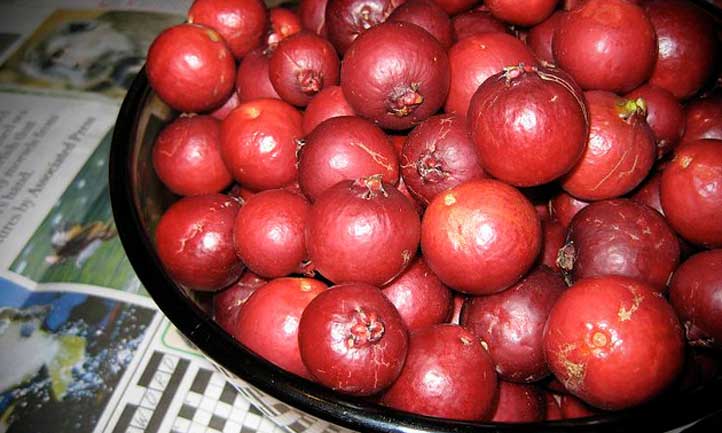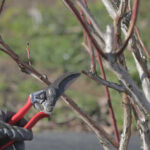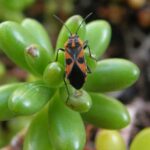Strawberry guava tree is a beautiful, fruit-bearing shrub that is native to South America, specifically Brazil. Closely related to common guava, the plant is an excellent candidate if you want to grow fruits in your backyard. As a landscape plant, strawberry guava has a bit of everything:
- Deeply-colored foliage
- Beautiful form
- Dark, patterned bark
- Sweet-tasting fruits
It goes by the scientific name of strawberry guava (Psidium cattleianum). The plant is simple to care for and grow. Also known as cattley guava, the tree has a shallow root system, which makes it perfect for growing near your house as an attractive border. Since it’s native to Brazil, it grows best in a tropical climate.
Its dainty white flowers and fresh fruits also qualify strawberry guava trees as an architectural accent. If you’re looking to attract colorful wildlife to your backyard, consider growing cattley guava. The fruits can be enjoyed as a sweet feast by not only children and guests but also squirrels and birds. Nurturing a red strawberry guava tree is a rewarding experience. Here’s a quick guide on how to grow it in your backyard.
Quick Care

| Common Name(s) | Strawberry guava, Cattley guava, Cherry guava |
| Scientific Name | Psidium cattleianum |
| Germination Time | 4-6 weeks |
| Days to Harvest | The fruit ripens in 90-150 days |
| Light | Full sun |
| Water: | Regular |
| Soil | Rich, sandy loam with pH 5-7 |
| Fertilizer | 3x per year in spring, summer, fall |
| Pests | Black scale, ants, fruit flies, root-knot nematode |
| Diseases | Algal leaf spot |
Strawberry guava tree has a shallow root system that bears white flowers in spring. Clusters of berries that ripen in the summer follow the beautiful blooms. Once these berries attain a cherry-red color, they’re ready to devour. The fruit tastes like a sweet and tart strawberry.
The tree or bush is very adaptable and can be grown outdoors. Even when it typically prefers warmer climates, the strawberry guava tree is quite hardy in temperatures as low as 22°F (-5°C).
As an evergreen shrub, red strawberry guava tree can reach a height of 15-20 feet, but should ideally be pruned to 12 feet in height, because the root system is relatively shallow and weak. If the cattley guava tree gets too tall, it could easily topple over from strong winds.
Strawberry Guava Varieties
The strawberry guava tree belongs to the Myrtaceae family. Although it doesn’t have known cultivars, the plant has closely-related shrubs from the same family. One such bush is Psidium guajava, also known as common guava or lemon guava. This shrub bears juicy fruit and grows up to 10-15 feet in height.
The plant is frost tender and native to the Caribbean, South America, and Central America. Although the bush grows to the same height as strawberry guava, it’s not as wide. It’s also not as hardy as the plants of strawberry guava, either.
Apart from Strawberry guava, the other closely related species is Pineapple guava or Feijoa sellowiana. This one has smaller and more succulent tart fruits. They grow wider than tropical guavas and slightly shorter than 12 feet in height. However, the shrub quickly produces a high yield in a short time. Pineapple guavas are known for being the most frost tolerant and are quite hardy to low temperatures.
All of the varieties need ample water, sunshine, and rich, well-drained soil to grow well.
Planting Strawberry Guava
Here’s a quick brief on how to plant strawberry guava and what to expect in the weeks post-planting.
Seed Availability
Strawberry guava tree spreads by shoots and seeds – the latter often a work of birds. You can find the yellow seeds at specialty nurseries or online seed companies. Rest assured, strawberry guava seeds are readily available.
Germination Info
To ensure the seeds germinate on time, plant them in moist, sterile soil with a warm temperature of 70-85°F (21-29°C). The estimated germination time is 4-6 weeks and could also take up to 12 weeks, depending on the quality of the soil and temperature consistency.
When to Plant
Spring is the perfect time to plant a strawberry guava tree. The soil is more workable, there are high chances of rain, and the sun is out most of the time.
Where to Plant
Strawberry guava typically needs a tropical habitat, resembling that of Brazil. They can be planted in your garden, outside your house, or can be grown as a small tree in your backyard. However, the plants are an invasive species, so it’s best to avoid planting in areas that you don’t want to be taken over!
How to Plant
Since guava seeds can be slightly tricky to germinate, you should keep the soil and temperature consistent. Plant the seeds ¼-½ inches deep into fertile, loamy soil. The soil temperature should stay between 70-85°F to ensure successful germination. If you’re planting indoors ahead of the season, or if you’d like to keep your tree in a container, use Air Pots. These are expertly-designed to support the tree’s root system.
Strawberry Guava Tree in Landscaping
Strawberry guava is excellent for edible landscaping. Both the fruit and plants can be used as an architectural accent, single yard specimens, or even as shelter plants. The foliage is so versatile and attractive that it can be used as a backdrop for smaller, more delicate plants and looks gorgeous planted along a driveway. If you have a patio or front porch, embellish the empty spaces with strawberry guava plants.
Strawberry Guava Plant Care

The plants and fruit are ideal for beautifying your garden. Here’s a breakdown of the plant’s sunlight, watering, and soil needs.
Sun and Temperature
Strawberry guava can spread fast and grows well in full sun. It grows well in warmer temperatures, typically between 70-85°F (21-29°C).
Water
The tree needs regular, ample watering. Although the plants can tolerate short periods of drought, guava red trees need proper hydration. They need even more water during fruit development so the berries can ripen properly. Regular irrigation at least once a week, once the plant matures, is good enough to maintain healthy growth.
Soil
Strawberry guava needs well-drained, loamy to sandy loam with an acidic pH between the ranges of 5 and 7. The soil should also be quite rich in organic matter and slightly warm. Cooler soil temperatures can inhibit the germination of the seeds.
Fertilizing
The plants need fertilizer thrice a year – in summer, spring, and fall. Use a high-quality granular citrus fertilizer with a ratio of 6-6-6 for the best results.
Pruning
Strawberry guava plant naturally stays in shape; however, if you’re planting it for landscaping purposes, a little pruning can go a long way. They have a naturally pretty form. Nonetheless, you can cut off any branches that are invasive or growing outside the borders. Tipping the branches will also mean bushier growth if that’s what you want. The ideal time to prune is in fall, once the fruit season is over.
Propagating Strawberry Guava
You can propagate by seeds or cuttings
Start by removing the seeds from the ripe berries. Wash them nicely to get rid of all the pulp around the seeds. In case you’re not planting them right now, you can store them in the fridge or an airtight box.
Using a sharp knife, break the seed’s outer shell, and place them in lukewarm water. Allow soaking for up to 1-2 days until they appear to double in size.
Now take a seed-starting medium and mix it in water. Take a seed-starting tray that will be used for the propagation and pour the medium into it.
Place a few seeds (2-3) in each cell of the tray and pour over the seed-starting medium. Hydrate with a spritz of water and cover it.
Next, take a heating pad and warm it up. Cover it with a thin muslin cloth or plastic wrap to prevent contact with water. Place the seed-starting tray on the heating pad and set it to low. The temperature and moisture levels of the tray will warm up slowly.
Make sure the temperature remains between the ranges of 75 and 80 degrees F, with regular misting. Wait for 2-8 weeks until the seeds germinate.
Once the seedling grows at least two sets of leaves, transplant them to smaller containers and keep under full but indirect sunlight.
Harvesting and Storing Strawberry Guava

Harvesting
Strawberry guava trees typically bloom throughout the year in mild climates. However, the best time is spring. The fruit properly ripens between 90 and 150 days, once the flowers have finished blooming. If left to ripen on the tree, fruits develop a better flavor.
The trees continue to grow after transplanting and bear fruit after 2-4 years. Although the trees can survive as long as 40 years, their fruit production declines after 15 years.
Storing
If you want to store the fruit, it’s best to store the berries when they are still green. You can keep them in the fridge for up to 3-5 weeks without rotting. Overripe berries tend to bruise within a few days. The best way to store strawberry guava fruit is to wrap it up in plastic and keep it in cold storage or a fridge.
Uses
Strawberry guava Psidium cattleianum has many medical benefits. The plant has potent anti-bacterial, antiseptic, and anti-microbial properties. It is extremely rich in vitamin C, Dietary fiber, Magnesium, and Potassium. Its high vitamin C content makes it a powerful disease-fighting plant for a stronger immune system.
Since it has high fiber content, consuming yellow strawberry guava also regulates bowel movements and helps flush out toxins. Above all, the strawberry guava tree is so nutrient-dense that it is also used for wound-healing and to improve the skin’s elasticity. All these benefits are enjoyed by consuming the fruits and seeds of the plant.
Many cultures roast the seeds of the guava strawberry plant and enjoy them as a substitute for coffee.
Fruit Taste
As aforementioned, the strawberry guava tree has a sweet but slightly tangy flavor, resembling that of strawberries. The guava fruit has a thin skin on top that tastes like rose petals. The fruit has a creamy white interior with small edible seeds. All in all, the fruit is quite aromatic and tastes like a strawberry, lime zest, and sometimes, passionfruit.
Fruit appearance
The fruit appearance of the Strawberry guava tree is quite striking. Once ripe, the fruit turns a rich maroon to dark red. The size of the fruit can be as small as a dime or slightly bigger, like a golf ball. The flesh of guava strawberry is white and yellow with splashes of pinkish-red hues. The seeds are yellow and hard.
Troubleshooting
Strawberry guava tree is an attractive shrub that requires low maintenance. However, it’s crucial to monitor the growth of the plants and protect them from certain pests and diseases.
Growing Problems
Although the shrub is easy to care for, it is invasive, meaning it will spread quickly if not pruned in time. It’s important to cut any invasive branches as well as dead stems. It’s also essential to keep it under full sun and grow in warm soil. Not doing so can prolong the germination period.
Pests
The berries are vulnerable to fruit flies, black scale, ants, and root-knot nematode. If growing in a container, the best way to prevent fruit flies is by covering the potting soil with a layer of aquarium gravel or coarse sand.
By covering, you’ll keep the flies from laying their eggs on the topsoil as well as newly hatched larvae from coming up. Black scale infestation can be controlled by regularly pruning a few branches to increase airflow and encourage more sunlight for the lower limbs.
Pruning will dry up the leaves and control black scale. Manage ants by setting natural traps made with boric acid and sugar water. The solution will keep them from climbing up the tree.
Although root-knot nematodes aren’t that common, trees grown in sandy soil are vulnerable to these pests. They can damage the fruit and are hard to control. The best way to prevent them is to ensure optimal growth conditions and regular irrigation and fertilizer to keep the trees vigorous and keep the pests at bay.
Diseases
Strawberry guava plants can catch algal leaf spot. The best prevention method is proper soil drainage, regular hydration, and of course, a high-quality fertilizer. Pruning the plants will also improve air circulation, while ample sunlight will control humidity levels.
FAQs
Q. How long does it take for a guava tree to bear fruit?
It takes 2-4 years for the tree to bear fruit.
Q. How big do strawberry guava trees get?
Strawberry guava trees can reach a height of up to 15-20 feet.
Strawberry guava tree is a beautiful and luscious shrub for your backyard. Use the plant guide above to grow and care for it. In no time, you will be able to enjoy the sweetest-tasting fruits!









